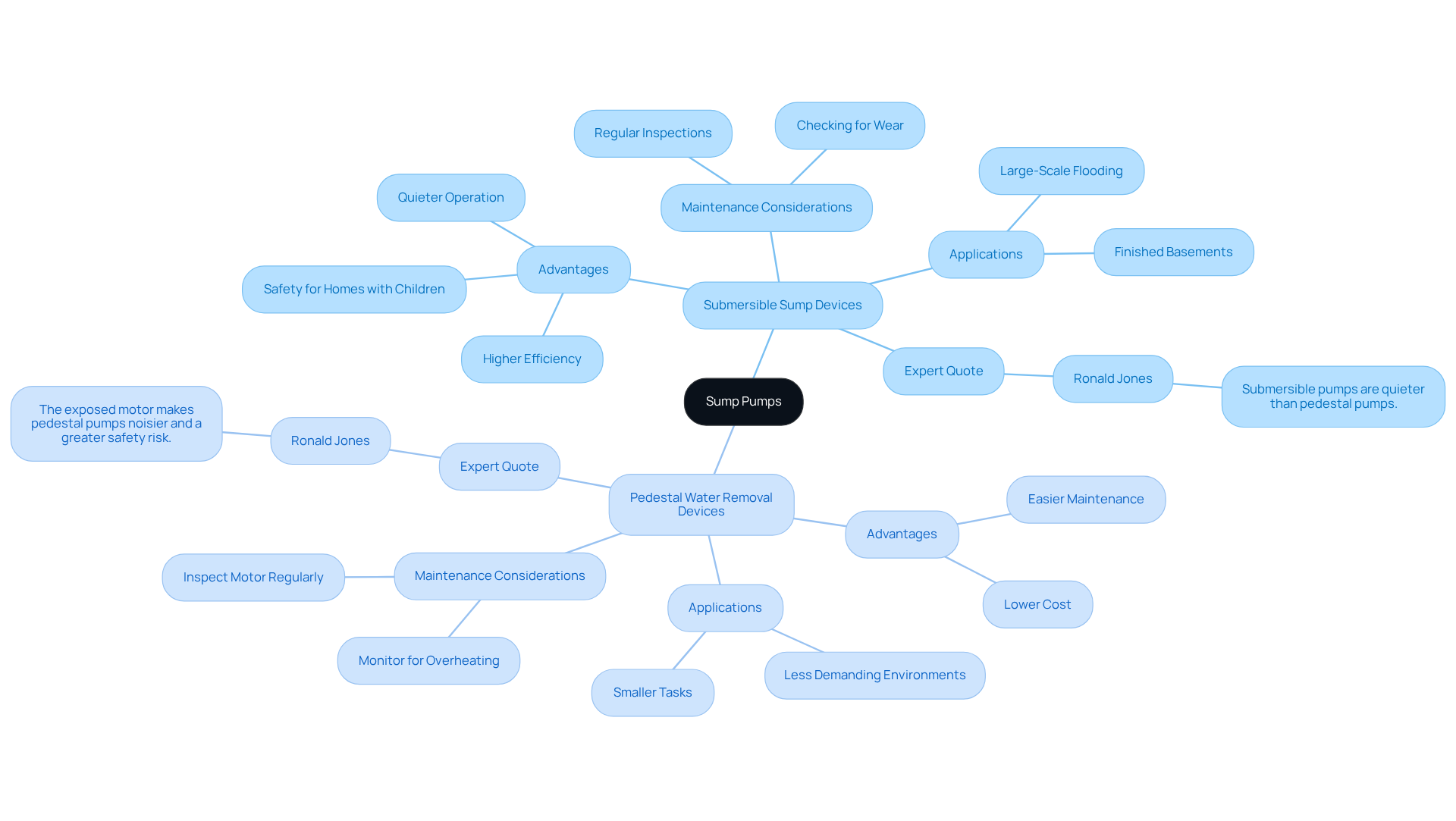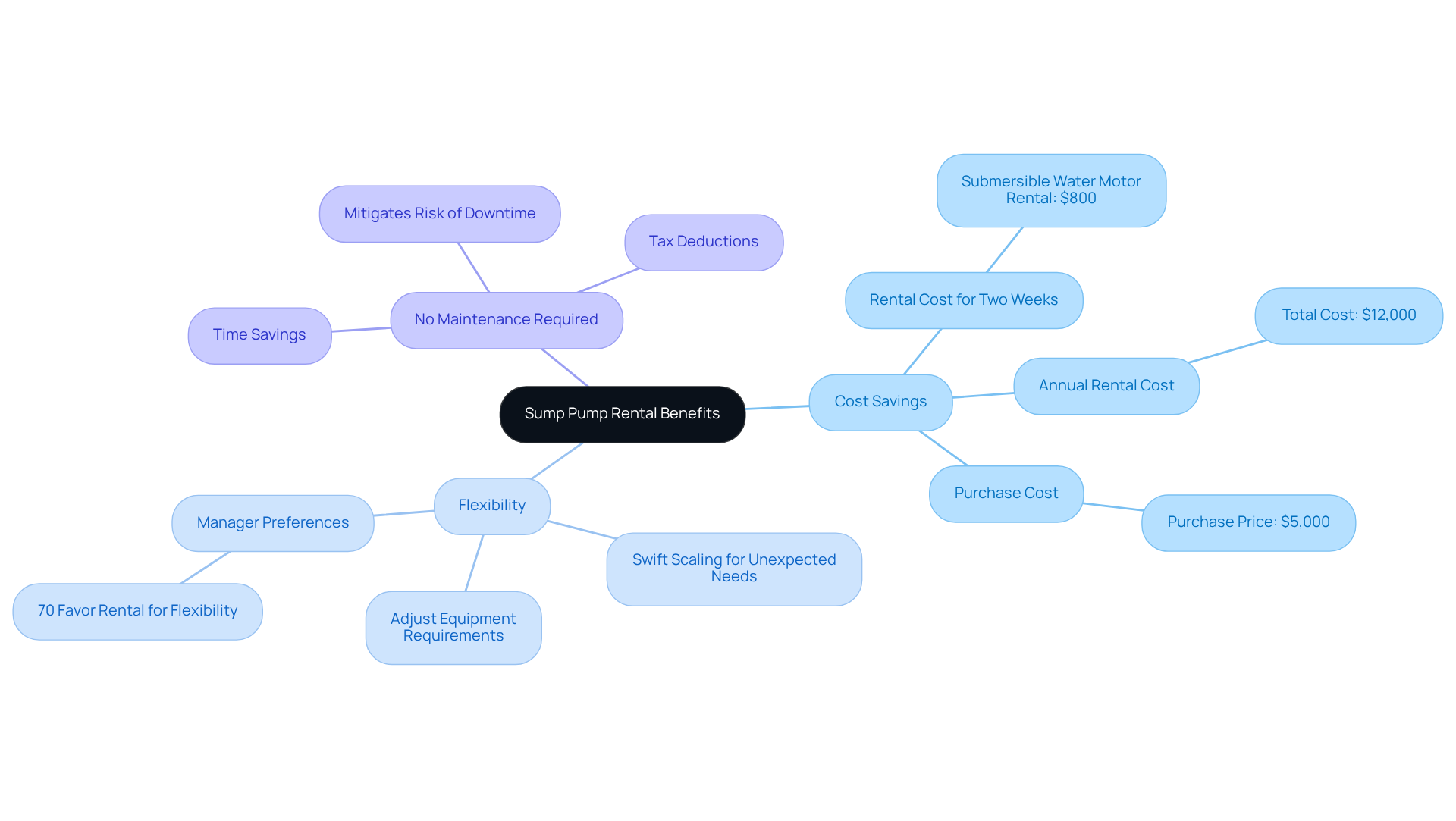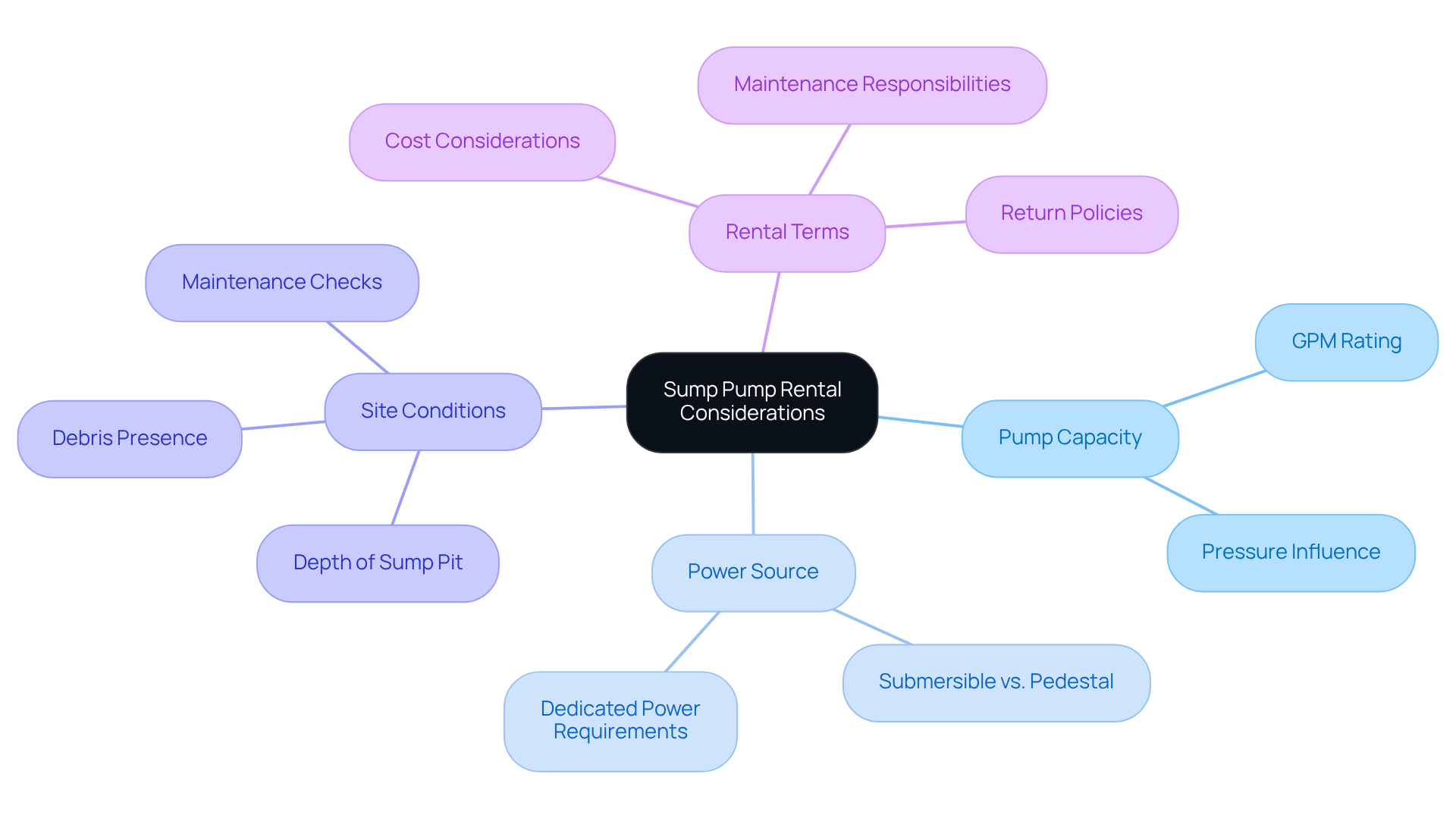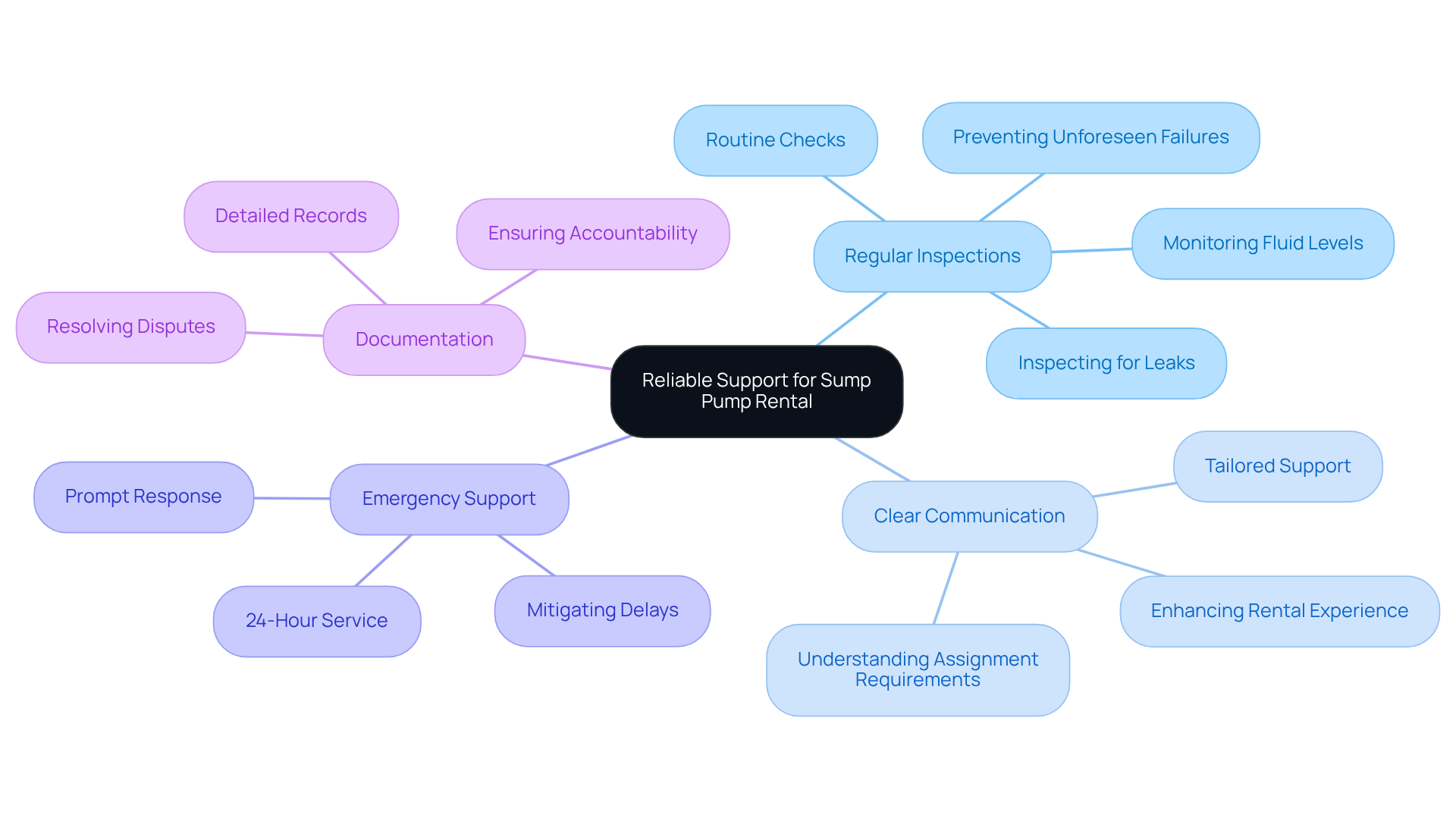Overview
This article outlines essential practices for project managers in the rental of sump pumps, underscoring the critical nature of selecting the appropriate type and understanding the associated rental benefits.
Choosing between submersible and pedestal pumps based on specific project requirements is vital.
Regular maintenance and clear communication with rental companies are also emphasized, as these factors can significantly enhance efficiency and reliability in managing water in flood-prone areas.
By focusing on these key practices, project managers can ensure optimal performance and reliability in their operations.
Key Highlights:
- Sump pumps are critical for managing water in flood-prone areas, with two main types: submersible and pedestal.
- Submersible pumps are more efficient for large volumes of water and operate quietly underwater, while pedestal pumps are easier to maintain but may be noisier and less powerful.
- Renting sump pumps offers cost savings, flexibility for project demands, and eliminates maintenance responsibilities for managers.
- The average installation cost for a drainage pump is around USD 1,400, with a range from USD 500 to USD 4,000.
- Key considerations for renting a sump pump include pump capacity, power source, site conditions, and understanding rental terms.
- Regular inspections, clear communication with rental companies, and emergency support are crucial for maintaining reliable sump pump operations.
- Documenting maintenance activities is important for accountability and resolving disputes with rental companies.
Introduction
Understanding the intricacies of sump pump rentals is essential for project managers tackling the challenges of water management in construction and flood-prone areas. This article explores vital practices that can significantly enhance efficiency and cost-effectiveness, ranging from selecting the appropriate type of sump pump to maximizing the advantages of rental agreements.
As project managers confront the choice between upfront purchases and adaptable rental options, a critical question emerges: how can they guarantee optimal performance while alleviating financial pressure?
Understand Sump Pumps: Types and Functions
Sump pump rental systems are essential for managing water in flood-prone areas, such as basements and crawl spaces. The two primary types of sump pumps include:
-
Submersible Sump Devices: These units are engineered to operate underwater, making them generally more efficient and capable of handling larger volumes of water. This design is ideal for significant flooding scenarios, as it allows for quieter operation and minimizes electrical hazards—an essential consideration for homes with children.
-
Pedestal Water Removal Devices: With a motor positioned above the pit, these devices use a hose that extends into the water. While they tend to be easier to maintain and more cost-effective, pedestal models may not match the power of submersible options. The exposed motor can result in increased noise and a higher risk of overheating, factors that are crucial in residential applications.
In construction projects, the choice between submersible and pedestal sump devices can significantly impact both efficiency and effectiveness. Submersible devices are often preferred for large-scale projects where rapid water extraction is critical, while pedestal units may be suitable for smaller, less demanding tasks.
Industry experts emphasize the importance of selecting the right sump pump rental based on specific job requirements. As Ronald Jones from Zoeller Pump Company states, 'Submersible devices are quieter than pedestal models and offer a greater level of safety in residences.' This insight underscores the necessity for project coordinators to evaluate the unique needs of their environments when selecting a sump pump rental as their drainage solution.
The average installation cost for a drainage pump is around USD 1,400, with prices ranging from USD 500 to USD 4,000. Understanding these financial implications is vital for project managers. Moreover, selecting the correct site for the pit is essential for optimal performance, as improper placement can hinder efficiency.
Recent advancements in drainage technology, such as the UltraSump 4 Battery Backup System—which can pump up to 12,000 gallons on a single charge—further enhance the reliability of these systems during power outages. Grasping the differences between these types of devices and their latest technological innovations is crucial for managers aiming to ensure peak performance during critical flooding events.

Leverage Rental Benefits: Cost-Effectiveness and Flexibility
Renting a sump pump, known as sump pump rental, offers significant advantages, particularly regarding cost-effectiveness and flexibility.
-
Cost Savings: Renting eliminates the substantial upfront costs associated with purchasing equipment, making it an ideal choice for short-term projects where the need for a sump pump is temporary. For instance, a two-week dewatering task might only require about $800 for a submersible water motor rental, in contrast to the $5,000 purchase price. Additionally, the financial benefits of choosing a sump pump rental over purchase are underscored by the $12,000 cost of renting for a year.
-
Flexibility: Rental agreements empower managers to adjust their equipment requirements based on task demands. In instances of unexpected weather conditions necessitating additional pumps, utilizing a sump pump rental enables swift scaling without the financial burden of ownership. Notably, over 70% of managers favor sump pump rental for its flexibility in adapting to changing task needs, as noted by industry specialists.
-
No Maintenance Required: Sump pump rental options allow rental firms to manage upkeep and repairs, enabling supervisors to focus on execution rather than equipment maintenance. This aspect not only saves time but also mitigates the risk of costly downtime linked to equipment failures. Moreover, leasing industrial equipment can provide tax deductions, further enhancing the financial advantages for supervisors.
By leveraging these advantages, leaders can enhance efficiency and alleviate financial pressure, making informed decisions that align with their operational requirements.

Select the Right Sump Pump: Key Considerations for Rental
When considering sump pump rental options, project managers must take into account several key factors to ensure optimal performance and efficiency.
-
Pump Capacity: It is crucial to assess the volume of water that needs to be removed. Pumps are rated by their capacity, typically measured in gallons per minute (GPM). Selecting a device that can manage the anticipated water flow is essential for efficient operation. Notably, the deeper a submersible device is submerged, the more pressure it generates, significantly influencing its capacity.
-
Power Source: Determining whether a submersible or pedestal device is more suitable based on the power source available at the job site is vital. Submersible devices often require a dedicated power source, so users should ensure that the equipment is connected to a working outlet before deployment.
-
Site Conditions: Evaluating the specific conditions of the site, including the depth of the sump pit and the presence of debris or solids in the water, is essential. These factors will affect the type of device required, as submersible models are designed to function efficiently in challenging settings, including those with elevated debris levels. Regular maintenance checks are critical, as frequent issues with submersible devices include clogged impellers, electrical problems, overheating, and noisy operation.
Understanding the rental terms for sump pump rental, including costs, maintenance responsibilities, and return policies, is necessary. Ensure that the terms align with the timeline and budget to avoid unexpected costs.
By thoughtfully evaluating these elements, supervisors can select the appropriate drainage device that effectively meets their requirements, ultimately improving results and reducing downtime. For instance, a homeowner discovered that maintaining a clear drainage area prevented blockages in their submersible device, underscoring the significance of site upkeep.

Ensure Reliable Support: Maintenance and Service Considerations
To ensure the reliable operation of sump pump rental units, project managers must prioritize essential maintenance and service considerations.
-
Regular Inspections: Conducting routine checks on the pump's performance is vital. This includes monitoring fluid levels and inspecting for leaks or unusual noises. Such a proactive strategy can prevent unforeseen failures; research indicates that a significant percentage of managers who perform regular inspections experience fewer operational problems.
-
Clear Communication with Rental Companies: Establishing a clear line of communication with the rental provider is crucial. Ensure they fully understand the assignment requirements and any specific maintenance needs. Effective communication fosters tailored support, ultimately enhancing the overall rental experience.
-
Emergency Support: Confirm that the rental company provides emergency support in case of equipment failure. Knowing that assistance is readily available offers reassurance during critical project phases. Prompt responses can significantly mitigate delays. For example, King's Sanitary Service offers 24-hour emergency service, ensuring help is always accessible.
-
Documentation: Keeping detailed records of maintenance activities and any issues encountered is essential. This documentation proves invaluable for future rentals and can aid in resolving disputes with the rental company, ensuring accountability and transparency. It is imperative to recognize that thorough documentation can address any disputes that may arise, underscoring the importance of maintaining clear records.
By prioritizing maintenance and support, project managers can significantly enhance the reliability of sump pump rental services, ultimately ensuring smoother project execution.

Conclusion
Mastering the art of sump pump rental is essential for project managers navigating the complexities of water management in construction and renovation projects. Selecting the right equipment not only enhances efficiency but also ensures safety and cost-effectiveness. Understanding the distinctions between submersible and pedestal sump pumps, along with leveraging rental benefits, lays the groundwork for successful project execution.
Key insights from the article emphasize the importance of:
- Assessing pump capacity
- Evaluating power sources
- Considering site conditions
when choosing a sump pump. Furthermore, prioritizing maintenance and establishing clear communication with rental providers can significantly reduce the risk of operational failures. By embracing these best practices, project managers can optimize their drainage solutions, ensuring they are well-equipped to handle any challenges that arise.
Ultimately, the significance of informed decision-making in sump pump rental cannot be overstated. By applying the guidelines discussed, project managers can save costs and time while enhancing the overall reliability of their projects. Embracing these strategies leads to more efficient operations and a greater ability to manage unforeseen water challenges effectively.
Frequently Asked Questions
What are the main types of sump pumps?
The two primary types of sump pumps are submersible sump devices and pedestal water removal devices.
How do submersible sump devices work?
Submersible sump devices operate underwater, making them more efficient and capable of handling larger volumes of water. They are ideal for significant flooding scenarios as they allow for quieter operation and minimize electrical hazards.
What are the characteristics of pedestal water removal devices?
Pedestal water removal devices have a motor positioned above the pit and use a hose that extends into the water. They are generally easier to maintain and more cost-effective, but may not be as powerful as submersible options. The exposed motor can lead to increased noise and a higher risk of overheating.
Which type of sump pump is preferred for large-scale construction projects?
Submersible sump devices are often preferred for large-scale projects where rapid water extraction is critical.
What should project coordinators consider when selecting a sump pump rental?
Project coordinators should evaluate the unique needs of their environments and select the right sump pump rental based on specific job requirements, as highlighted by industry experts.
What is the average installation cost for a drainage pump?
The average installation cost for a drainage pump is around USD 1,400, with prices ranging from USD 500 to USD 4,000.
Why is the placement of the sump pump pit important?
Selecting the correct site for the sump pump pit is essential for optimal performance, as improper placement can hinder efficiency.
What recent advancements have been made in sump pump technology?
Recent advancements include systems like the UltraSump 4 Battery Backup System, which can pump up to 12,000 gallons on a single charge, enhancing reliability during power outages.
Why is it important to understand the differences between sump pump types?
Understanding the differences between sump pump types and their latest technological innovations is crucial for managers to ensure peak performance during critical flooding events.




